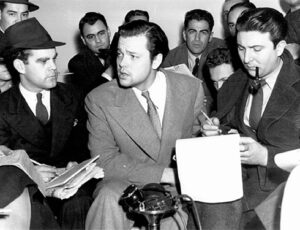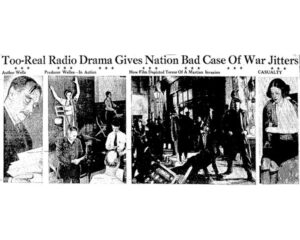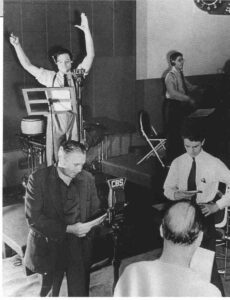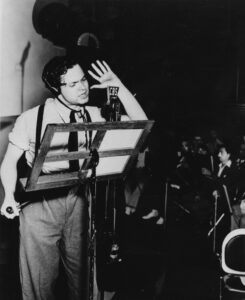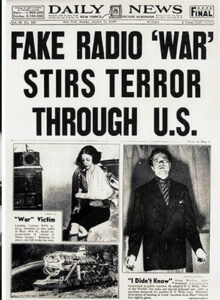Learning Unit 3:
Mass Media Effects
Effects of Mass Media on Individual and Society
It is a common belief that Mass Media have a tremendous power, that they determine the way the audience thinks and believes about any possible issue. When asked, that very same audience is convinced that Mass Media control the life of their neighbors and fellow citizens, though not necessarily his/her individual life. Mass Media are supposed to be in the hands of political and commercial elites that easily manipulate the masses with their powerful weapons (of Mass deception, as someone said).
The actual effects of Mass Media on individual and society are not that obvious, though. In many cases the influence goes the opposite way, i.e. it is not the Mass Media that controls the ideas or feeling of the audience, but the audience that determines the Media contents. These – sometimes subtle – effect of the Mass Media will be the subject of this learning unit.
You are expected to learn
1 – the historical development of Mass Media effects research (with special focus on a significant event, the radio broadcast The Invasion from Mars, by Orson Welles),
2 – the classic theories that try to explain the actual effects of Mass Media on the individuals (Selective Exposure, Gate-Keeping, Agenda Setting, Framing, Social Learning, Cultivation),
and finally
3 – how Mass Media might influence public opinion dynamics (i.e. the role of Mass Media in Elisabeth Noelle-Neumann’s theory of the Spiral of Silence).
Mass Media Effects Research – Brief Historical Development
To understand the development of mass communication research, we will follow a chronological order. There have been three main phases in the study of mass media effects. In the first era of mass communication studies, researchers tended to believe that mass media were formidable instruments of mass persuasion. In a second step, mostly after World War II, a number of theories appear that minimize the impact of mass media. In the late 1960s and early 70s, some scholars started to return to the idea or powerful mass media.
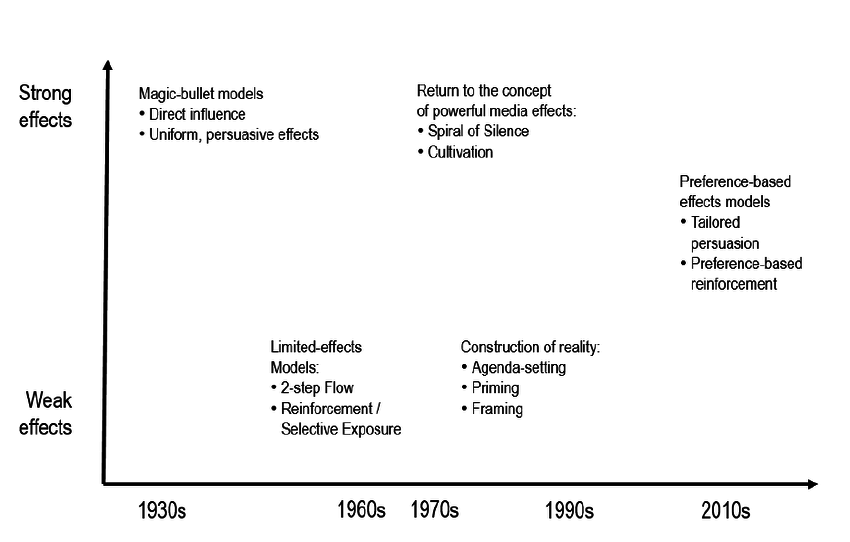
The Powerful Mass Media
Hypodermic Needle Model / Bullet Theory
According to the hypodermic Needle Model, each audience member receives messages directly from the source of a given medium, like an injection. The flow of communication is very simple. We consume the contents of the media, and these contents affect us directly. This was the prevailing idea in the first part of the 20th Century (as a result of the spectacular success of Orson Welles’ the invasion from Mars). Scholars also refer to this model of mass media effects as the “bullet theory”. As already mentioned in the second learning module, mass media were thought to be a powerful instrument to influence public opinion and to achieve political power. The idea of powerful mass media started to be challenged very soon, though.
The Paradigm of Minimal Effects
Two-Step Flow of Communication (Lazarsfeld, P.)
Paul Lazarsfeld was one of the first communication scholar who question the hypodermic needle model. In his opinion, the influence of mass media on individual and society was not always direct.
This author revealed the role of the informal opinion leaders in the process of mediated communication. Informal opinion leaders are those who do not have access to the media, but are influential in other circles of their lives, such as family, work, friends, etc.
Ideas and opinions flow from the mass media to the opinion leaders – and from these to the rest of the less active population.
Lazarsfeld also found that informal opinion leaders tend to consume more media that the average individual.
Lazarsfeld’s most important contribution to communication research was the weight of conformity in opinion processes. The word conformity has some pejorative connotations. It is associated to a deficit of character. Still, Lazarsfeld dissects in his book Personal Influence the social and individual benefits of conformity.
Click here to read about those benefits.
Multiple Step Flow of Communication
This Theory is a development of the previous one. There are different levels of opinion leadership (Family, Work, Studies, friends, etc). People who are opinion leaders in their families may adopt a rather passive role in the work environment.
And there are also Media that form the opinion of other media, opinion leadership among media. (The New York Times is more influential than The Hartford Courant, and The Hartford Courant more than The New Britain Herald).
Return to the Concept of Powerful Mass Media
This is the title of an article published by Elisabeth Noelle-Neumann in 1973 in the journal Studies of Broadcasting.
Noelle-Neumann, a controversial German scholar, tried to reverse the hypothesis that mass media can only have a limited influence on their audiences. To understand the depth of the power of mass media, it is necessary to explain Noelle-Neumann’s main theory: the Spiral of Silence.
The main statement of this famous theory is that opinions that are not expressed in public, spoken out, tend to fade away, and finally to vanish. This fact explains the dynamics of public opinion, how specific public opinions arise or change.
The Hypothesis of the Spiral of Silence is based on three assumptions:
- The human being has a social nature, what Elisabeth Noelle-Neumann calls our social skin. We fear isolation and tried to avoid expressing ideas that are in contradiction with what our neighbors think and feel.
- Every individual has also the capability to perceive the climate of opinion. We can perceive what the people around think about controversial topics, and decide to speak out or remain quiet based on that.
- Silence play a decisive role in public opinion dynamics. Ideas that are un-expressed, become un-thought, and finally, un-thinkable.
Media are very powerful when it comes to determine those particular dynamics of public opinion, because they can create what Noelle-Neumann calls a “dual climate of opinion”, which happens “when the climate of opinion among the people and the dominant among media journalists diverge”.
The dual climate of opinion leads to a state of “pluralistic ignorance”, where people misjudge people, i. e. the individuals have a wrong perception of how the majority of the citizens in their country feel about certain issues.
Since the perception of the social environment is essential for the individual decision of speaking out or keeping silent, the media have the power to influence public opinion on the long run.
And media achieve this power because of their capability to articulate public opinion. Groups of people whose opinions are not present in the media are mute. Average individuals need to look for guidance in the media. Newspapers, radio and TV shows provide them with the words and arguments to defend their point of view. If those opinions do not appear in the media, people who hold them will opt for the silence. And those ideas will finally vanish.
Mass Media Effects – Classic Theories
When I discuss the topic Mass Media Effects, I like to recall the origin of the research in this field, how everything started.
And everything started the Halloween evening of 1938, one of the most interesting episodes in the U.S. history of the 20th Century.
That evening, Orson Welles directed a life radio broadcast program with the title: “The Invasion from Mars”. The fictional radio show was based on “The War of the Worlds”, a popular science-fiction novel by H. G. Wells.
Welles’s program – and the novel – was about the invasion of the earth by inhabitants of the planet Mars. (You may know the last filmic version of this novel directed by Steven Spielberg starring Tom Cruise).
The amazing event of that Halloween evening of 1938 was that almost 6 million American citizens believed that America was actually being invaded by Martians. Many of them panicked and left their houses trying to escape from the invasion to who knows where.
The radio shock made Orson Welles famous overnight. He signed a contract with the film studio RKO and became one of the most relevant American filmmakers (two years after “The Ivasion from Mars”, he released “Citizen Kane”, which is regarded by many film critics as the best movie ever).
This episode, which belongs now to American Histor, opened the eyes of the Communication Researchers. If the people believe that they are being attacked by extraterrestrials, this was the starting thought, they will believe everything we tell them through the Mass-Media.
This is the reason why researchers started to investigate which are the actual effects of Mass-Media on individual and society.
Selective Exposure Theory
Ironically, the first outcomes of empirical Mass Media Research during the 1950ies seemed to deny any influence of Mass Media on individuals or society.
According to the findings of those pioneers in the field of mass communication, individuals expose themselves only to those messages that are in consonance with their previous opinions, while they tend to ignore every message that is in contradiction with their world of values and beliefs.
They called this phenomenon SELECTIVE EXPOSURE.
The selective exposure theory is based on Leon Festinger’s concept of “cognitive dissonance”. The individual, according to Festinger, needs to avoid ideas that are in dissonance to each other. When the individual becomes aware of this dissonance, one of the ideas needs to be rejected in order to keep the inner balance.
For instance, a convinced democrat voter may avoid negative messages about the democrat candidate (or positive ones about the republican one). Accepting those dissonant messages might force him/her to reconsider his/her own political standpoints.
The Selective Exposure theory minimizes the power of Mass Media.
The only possible effect would be reinforcing what we previously believed. If we avoid those messages that are in contradiction with our previous beliefs, media do not have the power to change our minds.
Gate-Keeping Effect
Although there is something true in this theory, it was also obvious that the Mass Media had an influence on our life and on our society.
Very soon, Kurt Lewin established the concept of GATE-KEEPING to describe the flow of information in mass communication.
In this context, a gatekeeper is any individual who has power over that flow of information, who can control what is going to be released to the public.
In mass communication we find whole networks of gatekeepers. Let’s say that you are working as a free lance PR writer. You produce a press release and send it to a newspaper. The assistant editor will first read your release. If this gatekeeper accepts it, it will go to the next step: the senior editor of this section of the newspaper. Still, whether the piece will be published or not, will be decided by the editor-in-chief. Whatever reaches the public needs to go through a series of filters. And of course, an important amount of information is filtered out in the process (for instance, only 20% of the press releases produced by PR departments and firms are finally published).
Agenda Setting Theory
Closely related to the Gate-Keeping theory – or as a consequence of this theory – the mass communication scholars Maxwell McCombs and Donald Shaw revealed in the 1970ies the so-called AGENDA-SETTING EFFECT OF MASS MEDIA
The agenda setting approach is a response to the selective exposure theory.
Even if the media cannot determine what we think because we tend to avoid those messages that are in contradiction with our beliefs, McCombs and Shaw proved that they can surely determine what we think about.
They select from the complex reality a couple of subjects.
And with this selection, they can determine what we are going to worry about, what we are going to talk and to discuss about, which topic we are going to have an opinion on. This is what we call news.
Whatever is not in the media will never get into our awareness. It simply does not exist for us. In this way, mass media shape how we perceive the reality.
Conceptually, the agenda setting theory goes back to Walter Lippmann vision of the problematic relationship between truth and news. It opened a new way of research. Up to that point, Mass Media effects research have been focusing on the so-called “persuasion paradigm”, i.e. how mass media might directly influence our opinions, values or beliefs. The agenda setting paradigm represents an epistemological shift from the “persuasion” to the “cognitive paradigm”, i.e. how mass media determine the way we perceive and deal with the reality.
Click here to read more about this topic: persuasive vs. cognitive paradigm
Click here to read the original Chapel Study by McCombs and Shaw.
Pseudo-Events
The media can set or build the public agenda not only selecting from the real world topics and issues.
The Historian Daniel Boorstin created the term PSEUDO-EVENT in his classic book “The Image” (1961) to refer to those stage events. Examples of pseudo-events are press conferences, personal appearances, awards ceremonies, electoral debates, or even the super-bowl. Almost 70% of what is reported in the media is the result of any kind of pseudo-event.
According to Boorstin, the main characteristics of Pseudo-Events are:
- It is not spontaneous, but comes about because someone has planned, planted, or incited it. Typically, it is not a train wreck or an earthquake, but an interview.
- It is planted primarily (not always exclusively) for the immediate purpose of being reported or reproduced. Therefore, its occurrence is arranged for the convenience of the reporting or reproducing media. Its success is measured by how widely it is reported. Time relations in it are commonly fictitious or factitious; the announcement is given out in advance “for future release” and written as if the event had occurred in the past. The question, “Is it real?” is less important than, “Is it newsworthy?”
- Its relation to the underlying reality of the situation is ambiguous. Its interest arises largely from this very ambiguity. Concerning a pseudo-event the question, “What does it mean?” has a new dimension. While the news interest in a train wreck is in what happened and in the real consequences, the interest in an interview is always, in a sense, in whether it really happened and in what might have been the motives. Did the statement really mean what it said? Without some of this ambiguity a pseudo-event cannot be very interesting.
- Usually it is intended to be a self-fulfilling prophecy. The hotel’s thirtieth-anniversary celebration, by saying that the hotel is a distinguished institution, actually makes it one.
Daniel Boorstin’s book was prophetic. The author was able to foresee that pseudo-events will become increasingly relevant in the mass communication society. Nowadays almost 70 % of the news we get from the different media (newspapers, magazines, TV or radio stations) is the result of some kind of pseudo-event.
Boorstin also explained the reasons why pseudo-events are overshadowing spontaneous events in the media.
- Pseudo-events are more dramatic. A television debate between candidates can be planned to be more suspenseful (for example, by reserving questions which are then popped suddenly) than a casual encounter or consecutive formal speeches planned by each separately.
- Pseudo-events, being planned for dissemination, are easier to disseminate and to make vivid. Participants are selected for their newsworthy and dramatic interest.
- Pseudo-events can be repeated at will, and thus their impression can be re-enforced.
- Pseudo-events cost money to create; hence somebody has an interest in disseminating, magnifying, advertising, and extolling them as events worth watching or worth believing. They are therefore advertised in advance, and rerun in order to get money’s worth.
- Pseudo-events, are easy to understand. Being planned for intelligibility, are more intelligible and hence more reassuring. Even if we cannot discuss intelligently the qualifications of the candidates or the complicated issues, we can at least judge the effectiveness of a television performance. How comforting to have some political matter we can grasp!
- Pseudo-events are more sociable, more conversable, and more convenient to witness. Their occurrence is planned for our convenience. The Sunday newspaper appears when we have a lazy morning for it. Television programs appear when we are ready with our glass of beer. In the office the next morning Jack Paar’s (or any other star performer’s) regular late-night show at the usual hour will overshadow in conversation a casual event that suddenly came up and had to find its way into the news.
- Knowledge of pseudo-events–of what has been reported, or what has been staged, and how–becomes the test of being “informed.” News magazines provide us regularly with quiz questions concerning not what has happened but concerning “names m the news”–what has been reported in the news magazines.
- Finally, pseudo-events spawn other pseudo-events in geometric progression. They dominate our consciousness simply because there are more of them, and even more.
Framing
Generally, the concept of framing is used in combination with the agenda setting effect of mass media.
Framing refers to the way we perceive the reality around us. We use pre-established cognitive structures in order to organize sensorial stimuli and the information we are exposed to. Those pre-existing cognitive structures, which Leon Festinger called schemata, are not neutral. They imply a judgment on people, situations, or actions. Such “frames” facilitate the immense task of making sense of the world.
When framing news, we are not only providing our target audience with information, but also giving them the necessary clues to interpret the events we are reporting. The capacity of framing issues gives media and journalists the power of determining (or at least influencing) how the audience will perceive those issues.
Example of framing: When reporting about an extramarital affair of one political candidate, you can use different frames to approach the issue: adultery, romantic love, sexual freedom. Every one of those frames will imply a different moral judgment of the action.
Click here to learn more about the two methodological approaches to investigate framing: Frame Building vs. Frame Setting
Social Learning Theory
Another important theoretical framework in the research of Mass-Media Effects is the so called SOCIAL LEARNING THEORY, developed by Albert Bandura and associates.
The main statement of this theory is that we learn how to act in private and public settings observing the behavior of the people in movies or TV.
The process is known as modeling (or imitation). Modeling goes throughout one’s lifetime, but it is especially important during the formative years of childhood.
Bandura et al. showed that, for instance, the more stars smoke on the screen, the more popular smoking became among the population.
It is interesting, in this regard, to compare the screen behavior of the 1940ies and 50ies on the screen (Humphrey Bogart is the best example) with the behavior of contemporary Hollywood icons.
Cultivation Effect
George Gerbner and associates discovered in the 1970s the CULTIVATION EFFECT of mass media.
This theory goes a step forward regarding other theories.
It says that our perception of the reality is determined by our Media Use. The more we watch TV, The more we think that the reality is like what we see on the screen. Heavy Media users, for example, overrate the violence in our society, even if they never were victims of violence themselves. They think that the percentage of Doctors and Policemen is much bigger than in reality, because Doctors and Policemen are over-represented in TV and movies.
Or that there are much more cases of adultery than in reality.
One of the consequences of the cultivation effect of mass media is what Gerbner called “Mean World Syndrome”. Since bad news are overrepresented in the media, and since violence plays also a essential role in movies and TV shows, people tend to believe that the world is a much more violent and evil place to live than it is in reality.

